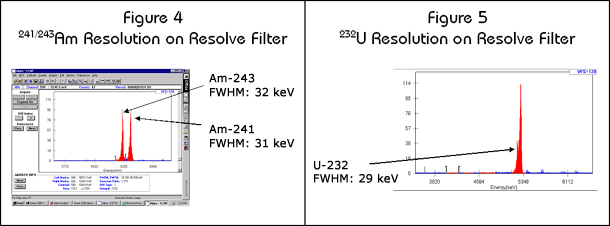Filters are typically manufactured to meet specifications for removal of particles to result in defined solution purity characteristics. For example, a 0.1 µm rated pore size filter is typically defined as capable of removing 99.98% of particles >0.1 µm from a liquid. The pores present on the surface of the filter, however, may be much larger or smaller than 0.1 µm.
Maximum peak resolution in alpha spectrometry requires a uniform filter surface to ensure a uniform deposition of the rare earth fluoride precipitate. Filters which allow significant penetration of the precipitated alpha emitting nuclides below the surface of the filter will produce alpha spectra with poor resolution due to self attenuation.
Recently reported resolution quality concerns indicate that manufacturing specifications and quality control procedures of many filter suppliers may not address the specific needs of alpha spectrometry. Eichrom’s line of Resolve™ Filters (0.1 µm polyethylene, 25 mm diameter) are manufactured to specifications which consistently provide high quality alpha spectra.
Scanning Electron Microscopy (SEM)
Figure 1 is an SEM micrograph of a typical lot of Resolve Filters at 5000x magnification. Figures 2 and 3 show micrographs of another supplier’s product at the same magnification. The lot in Figure 2 was reported to have poor alpha peak resolution performance, while the lot in Figure 3 was reported to have excellent performance. The poorly performing lot shows a number of very large pores (>1 µm), while the well performing lot shows a much more uniform pore size distribution. Eichrom’s Resolve Filters exhibit this more uniform pore size across all product lots and are extensively tested to ensure consistent performance in alpha spectrometry source preparation.
Performance in Alpha Spectrometry
Maintaining a more homogeneous pore size distribution in the membranes used in Resolve Filters, has allowed Eichrom to produce filters that give reproducibly good performance in alpha spectrometry. Eichrom continually evaluates lots of filters by obtaining alpha spectra from rare earth fluoride precipitation sources. Figures 4 and 5 show alpha spectra for a 232U and 241/243Am on a typical lot of Resolve™ Filters.
Quality Control
Incoming filter material is monitored and screened using scanning electron microscopy (SEM) to ensure necessary homogeneity of surface pore size distribution in our finished product. Additionally, the resolution (FWHM) and recovery of 241Am and 243Am are measured on each filter lot manufactured.
Product Validation
Early testing of the Resolve Filters suggested that the two sides of filters may perform differently in the preparation of alpha sources. The sides were characterized as glossy (shiny) and dull, although distinguishing between the two sides required very close inspection. Independent investigations of the filters have been performed by Eichrom and by Dr. Barry Stewart, at the Carlsbad Environmental Monitoring Research Center. Various parameters were investigated, including, “glossy” side vs. “non-glossy” side and the use or absence of carbon substrate. Dr. Stewart collected rare earth fluoride microprecipites of 241Am and 243Am on Resolve Filters using ASTM procedure C1163-98 (50 µg La carrier.) The results of this study are shown in the table below. The Carlsbad results indicate that each side of the filter works equally well and that excellent peak resolution of the 243Am peak (< 30 keV) could be achieved with or without the use of substrate on the filter.
| Sample | Substrate? | Orientation | FWHM (keV) | 243Am Recovery | 241Am Recovery |
| 1 | No | Glossy down | 28 | 98.4% | 98.4% |
| 2 | No | Glossy down | 25 | 95.7% | 95.5% |
| 3 | No | Glossy up | 22 | 101.9% | 97.6% |
| 4 | No | Glossy up | 26 | 100.2% | 99.3% |
| 5 | Yes | Glossy down | 25 | 100.5% | 96.1% |
| 6 | Yes | Glossy down | 23 | 98.6% | 97.0% |
| 7 | Yes | Glossy up | 25 | 95.1% | 94.8% |
| 8 | Yes | Glossy up | 26 | 97.6% | 95.0% |
A similar study conducted at Eichrom evaluated the peak resolution of the two Am isotopes on each side of the filter. In this case, the geometry of the filter was described by the orientation of that filter surface in the roll of material prior to cutting into filter discs, inside and outside. In this study, alpha sources were prepared following Eichrom’s procedure SPA01 (50 µg Ce). As shown in the following table, the FWHM of the 241Am and 243Am peaks did not vary significantly as a function of the filter geometry.
| 243Am Outside | 243Am Inside | 241Am Inside | 241Am Inside |
| 36 | 29 | 41 | 26 |
| 28 | 22 | 33 | 37 |
| 31 | 38 | 32 | 45 |
| 32 | 35 | 37 | 44 |
| 43 | 42 | 37 | 42 |
| 43 | 41 | ||
| mean = 34 | mean = 33 | mean = 36 | mean = 39 |
| Std. Dev = 7 | Std. Dev. = 8 | Std. Dev. = 4 | Std. Dev. = 8 |
The pore size distribution of Resolve Filters and their performance in alpha spectrometry are monitored in Eichrom’s QA/QC program. While the actual peak resolution that is observed is a function of many factors, Eichrom’s QC program ensures that the filter itself should not contribute significantly to poor resolution in alpha spectrometry. Resolve Filters are available in packages of 100, part number RF-100-25PP01.

